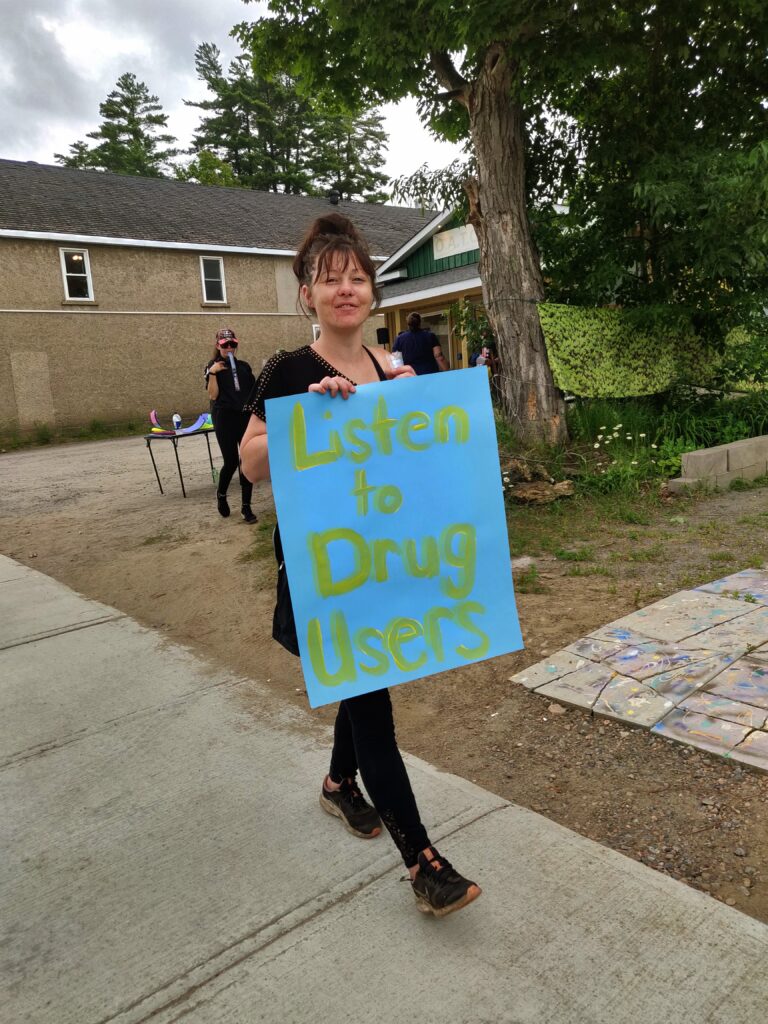Third annual Silent Walk honours victims and raises awareness of ongoing overdose epidemic

By Bill Kilpatrick
On June 23 at 11a.m. a group of around 25 people gathered in front of the Ontario Addictions and Treatment Centre for the third annual Silent Walk to honour the victims of drug overdoses. The event was coordinated by the North Hastings Community Trust and the Ontario Addictions Treatment Centre. The purpose of the walk is to raise awareness about the ongoing stigma related to drug use and homelessness, and to talk about prevention and the importance of Naloxone and Narcan kits in reducing overdose deaths. “We had a huge spike in overdoses during the COVID-19 pandemic and that's what sparked this event to happen. We are continuing a walk every year to raise awareness and let folks know what's going on,” says Victoria Burke, and the harm reduction and outreach coordinator at North Hastings Community Trust. “Prior to the COVID-19 pandemic Bancroft was losing two to three people a year to overdose deaths. During the COVID-19 pandemic it spiked into the mid-teens and since the pandemic, I believe [that since the end of the pandemic] the numbers have come down,” added Burke. “The COVID-19 pandemic really drew the curtain back in terms of substance use and homelessness in Bancroft. It became visible,” stated Burke, adding that the ongoing affordable housing crisis that began during the pandemic has resulted in less and less places for homeless people to stay, “before there might have been maybe eight houses downtown for people to congregate in, now there's probably none.”
Although there has been a decrease in overdose deaths since the pandemic ended, homelessness and overdoses remain a serious problem, and more needs to be done says Burke. This decrease in overdose deaths has partly to do with the accessibility of Naloxone and Narcan overdose prevention kits, but as Burke points out, “more people need to know how and when to use them.” Burke also spoke about the ongoing stigma related to homelessness and drug use and how that stigma isolates and targets people. As a former addict herself she says that the ongoing stigma, “hurts, it really does. It feels crappy and it's just pushing people out more who are just trying to have their basic needs met.”
There has been a marked increase on the streets of Bancroft in terms of the number of homeless people and those suffering from addiction who have nowhere to go. The vestibules at both the local banks became common places to stay warm overnight and were frequented by those who could not find a warm place to stay, until, as a result of safety concerns, both branches closed and locked their vestibules over the winter of 2022-2023. The lack of a warming space over the winter prompted concerns about people freezing to death and as a result the Community Trust held a Theatre of the Oppressed in January of 2023 to raise awareness, build empathy and help people understand what was happening to those experiencing homelessness and addiction. The Community Trust, with funding from the County of Hastings and United Way then opened a warning center to help avert a potential humanitarian crisis.
Joe Kidman, who is currently homeless and using substances, pointed out that despite having multiple jobs, “The rent is so high we can't afford to pay it,” adding that, “my friend and I have a little six by eight bunkie that we sleep in and it keeps us warm and keeps us alive.” Kidman, who lost a friend to an overdose death in Peterborough the past winter says that without his bunkie and the warning centre that opened at the Community Trust on February second, which was a result of a lot of pressure on local governments and agencies, things could have gone very badly for those in the homeless community. Kidman spoke about feeling that he was labeled as a criminal and then being chased out of local businesses and then being banned after he went in to just get warm. Kidman says that he feels that local stores ban people just from the way they look. “This is what choices they leave us to live,” says Kidman, “and the stigma is getting much worse.” Burke points out that there is a large gap in services for men between 30-40 years of age who may be suffering from addictions or homelessness. Burke recognizes that it is not always easy to house people with addictions issues, but that with proper supports, less stigma, and a little more understanding it can get much better.
After the opening remarks by Burke and Kidman those in attendance picked up signs and silently walked through the streets of Bancroft. Their signs said things like, “No more lost to overdose deaths,” “Addiction is not a crime,” and “They were loved. They will be missed.” The group received multiple honks in support and thumbs up from passing vehicles as they held their silent vigil. Once the group returned to the addictions clinic they then each shouted out names of those who they have lost to overdoses, many of the participants were moved to tears as they remembered those lives of friends and loved ones that were cut short. “I don't want to be one of those people and I don't want any more of my friends to be one of those people,” said Kidman. “It's not just people who are homeless who experience overdoses, it's people who have homes and people who are older. It can accidentally happen to anybody at anytime,” stated Burke adding, “whether they die of an overdose or not it's hard to lose somebody and we'll keep doing this until the problem is over.”
|
